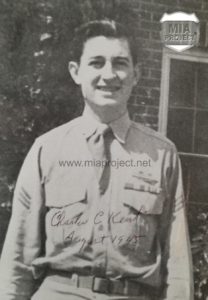 Charles C. Kent was born on March 11, 1923 in Jasper, Texas. He was raised by his Grandfather then later moved to College Station to live with an uncle. After graduating from hi-school in 1940, he entered Texas A&M University. A&M at the time was all male students. Reserve officer training was required of all physically fit students. After training with the coastal artillery for two years, he volunteered for the Army.
Charles C. Kent was born on March 11, 1923 in Jasper, Texas. He was raised by his Grandfather then later moved to College Station to live with an uncle. After graduating from hi-school in 1940, he entered Texas A&M University. A&M at the time was all male students. Reserve officer training was required of all physically fit students. After training with the coastal artillery for two years, he volunteered for the Army.
“ …I enlisted in the Army as a Private in January 1943 and reported for active duty at Camp Beauregard, Louisiana on June 04, 1943. I was then sent to Fort Riley, Kansas, and had 13 weeks of Basic Infantry Training. Most of the men I trained with were sent to the Pacific theatre. The Army hadn’t supplied me with GI issue glasses so I was held back until they did. I ended up staying in Ft Riley for three months, doing work details and goldbricking. In February of 1944, I was sent to Camp Maxey,Texas and joined the 99th Inf Div. I was attached to Company B, 394th Inf Regt…”
The first week of December 1944, the first Battalion left its reserve position and deployed east of Losheimergraben, Belgium. The hamlet, a little custom post on the Belgian-German border, was sitting at a road junction. There were a few buildings for the custom guards and clerks, and 300 yards to the East, three brick houses for their families. All had been evacuated in September and now served US troops. The battalion was deployed in a large arc east to southeast of Losheimergraben. The front to cover was way too large and the companies were spread in the dense forest with very limited fields of fire. Company B had its squads and machine guns spread widely in the forest, covering shallow depressions, little openings or fire breaks. It was not a continuous line of resistance like in other sectors.
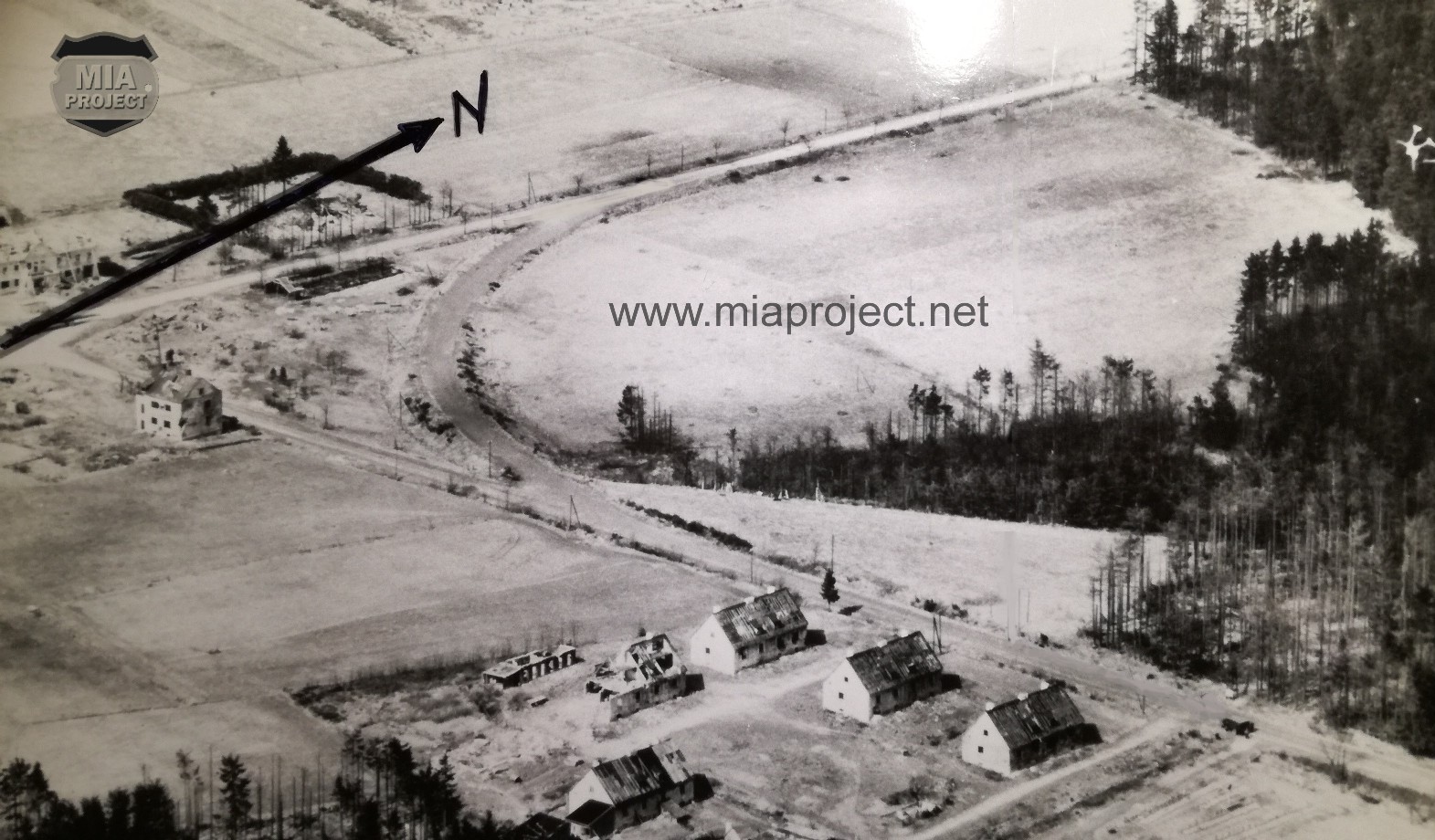
Losheimergraben. Custom buildings on the far left, personnel brick houses on the right (East) – Hatlem collection 1947
“ … When I first went on the line, continues Kent, I clearly remember what a tough march it was to get there. It was only a few miles but the snow was deep, the road was iced over, we had the wool overcoats, full field packs, a lot of extra ammo. I was carrying eight rifle grenades in addition to extra rifle clips. It seemed you would take two steps forward and slid back one. We did not have to dig in as we were to move into positions already dug by the outfit we were replacing. After we got settled in, it was not too bad, we actually did very little…daily occupation was clean weapons, improve foxholes, write letters or visit a friend in the squad area. One incident I remember well happened a day or two before the Bulge started. In order to see in our foxhole at night, Bill Sears and I got ration cans, punched hole in top, filled with gasoline, stuffed a piece of cloth rag for a wick and then light the cloth. We could then read or write letters. The front of the foxhole was covered with a pup tent half. One night I knocked a can over. It spilled gasoline on Bill’s sleeping bag and caught fire. Bill was about half way in the bag and zipped up to his waist. He was out of the hole, rolling in the snow in seconds and wasn’t even out of the sleeping bag! That was the fastest I ever saw him move. That stopped the letter writing that night…”
On December 16, 1944, when the German artillery barrage started, Charles Kent was in a foxhole with S/Sgt Bill Sears. Sears was squad leader and Kent was his assistant.
“… I was asleep when the bombardment started…” recalled Kent “… and the first thing I was aware of was Bill praying the Lords prayer …. I began to pray also. After the barrage lifted, I checked the other foxholes of our squad to check for damage. We only had one man with a slight head wound. Our squad positions were in the forest but we had an open on the left. Before too long, a German scout showed up in front of us. We didn’t shoot so he wouldn’t have any information about us. He withdrew shortly after and our squad had no further contact with the Germans until late that afternoon…”
Volkgrenadier Regiment 48 by-passed most of the US resistance inside the forest to focus on their main objective, the capture of Losheimergraben crossroad.
“ … In the afternoon, I went … with two men to our squad left flank along the open field. We were there for two or three hours before we saw anything. Then a group of men, about 50 to 70, came from the rear of our company’s front line. They were half way across the field before we could tell … they were Germans… I kneeled on one knee to give a steady rest for my rifle. Then in a flash just before I pulled the trigger it seemed my whole life passed through my mind and I thought I will die here in these woods and my family will never know what happened to me. We started firing into them, hit a few but they continued until we lost sight of them. I was still afraid but … I thought this is what I have been trained for and why I was here. When the Germans went out of sight, I laid down behind a mount of dirt, this gave a good rest for my rifle. That was good except the pockets of my rifle belt froze in the snow making them very hard to open. After that I always kept two or three clips loose in my field jacket pockets. Shortly after that, the Germans reappeared and overran our squad position doing much yelling and hollering. Again I fired but quit as soon as I saw them get Bill Sears out of his foxhole. I figured I might hit Bill or might cause the Germans to kill him or one of the other prisoners. Then the Germans withdrew. All but one. He made the mistake of standing on top of a foxhole, looking around. I know I hit him with my first round and maybe two more before he hit the ground. I don’t know if he lived through it or not. For some reason, the Germans who overran our squad’s position, pulled back after capturing a few men. I was not killed or captured because the three of us were to the left rear watching the open field. At the time, it was not too long before dark…”
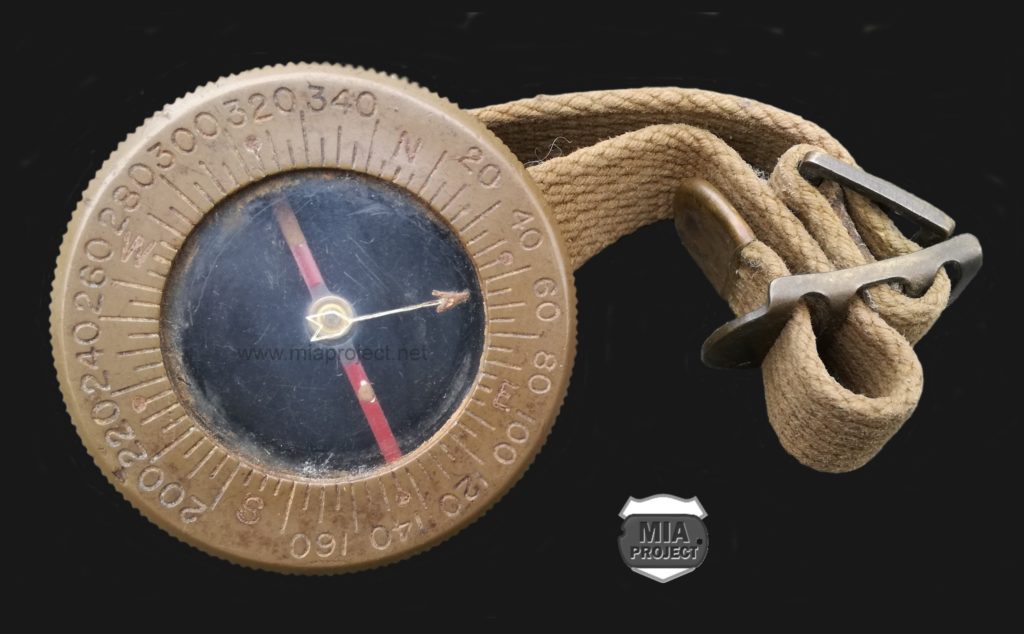
Wrist compass found by Sgt Kent in his company CP and used to reach Elsenborn cross country on December 17, 1944.
By then, Company A and B had been completely wiped out and remnants were painfully withdrawing to the Battalion CP area at the crossroad. Kent and his two men pulled back ad arrived at dark. “ … We were halted by our own men … and we told them the Germans had pulled back. It was decided to spend the night in the [custom] houses…”
Sometime later that night, a Lieutenant sent me back on patrol to B Co area. Our night patrol left the house … and followed the road until we came to our foxholes, then followed them to the clearing. We found no one. We then went to the Co CP log cabin. We loaded our pockets with candy and cigarettes and took them to Losheimergraben where they were most welcome. I doubt if anyone had eaten that day. On a table in the log cabin I also found a wrist compass and a trench knife. I liked it better than my bayonet so I took it…”
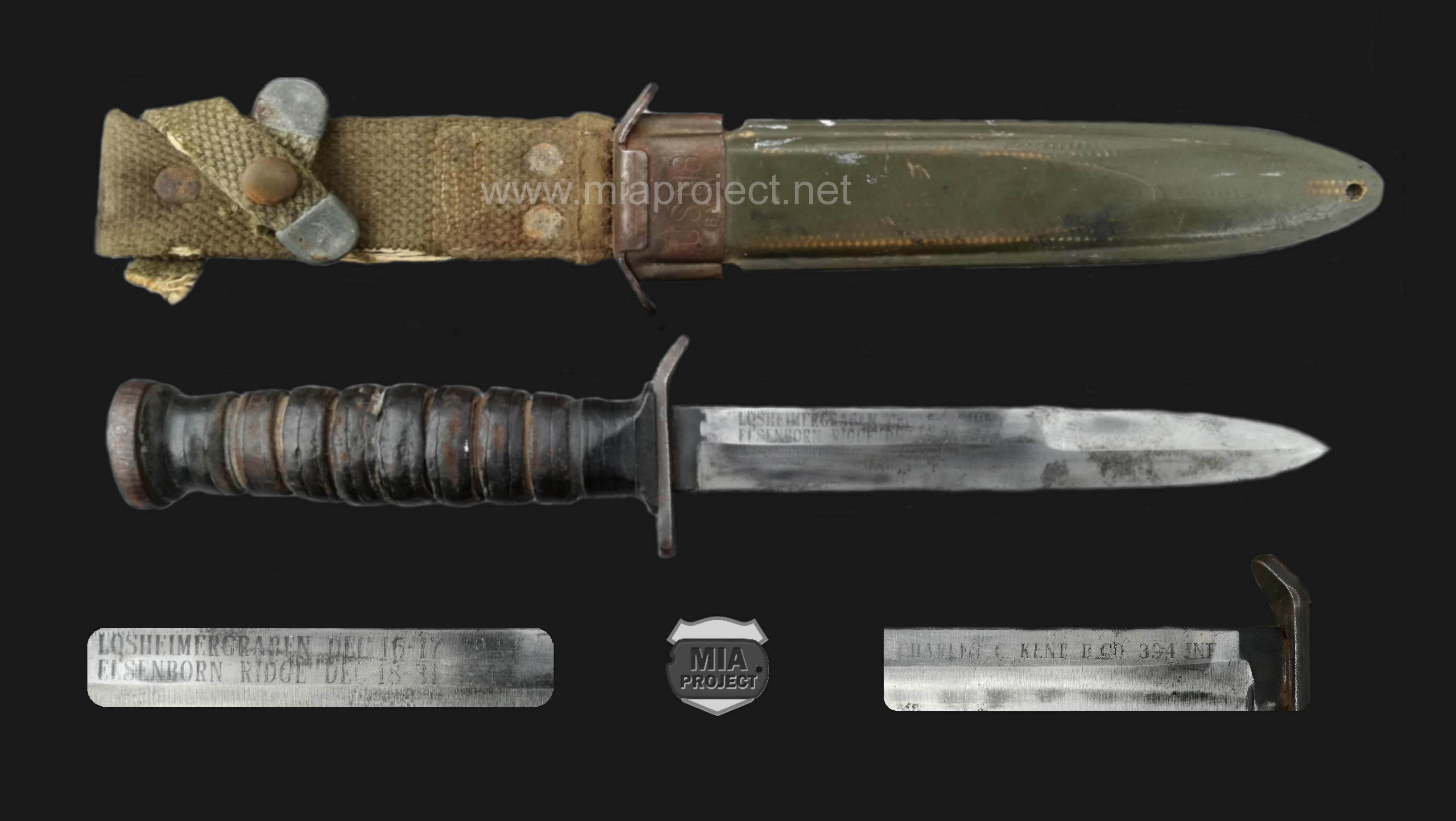
Camillus guard marqued M3 trench knife Charly found in B Company CP log cabin. He later customized the blade with » Losheimergraben Dec 16-17, 1944 – Elsenborn Ridge 18-31 Dec 18-31, 1944″ on one side and his name on the other.
The next day, the Germans resumed their attack on Losheimergraben with renewed vigor and eventually captured it in the late afternoon. LtCol Douglas received orders to abandon the crossroad and to pull back to Elsenborn via Mürringen and Wirtzfeld. The withdrawal, cross country on such a long distance, in complete darkness and by-passing German troops was extremely perilous. In Mürringen, some of the men chanced to board retreating vehicles.
“… There was a call : « Every body but the drivers off, form up over here ». I think the town was Wirtzfeld. After getting kinda organized we started a hike to what turned out to be Elsenborn. After reaching Elsenborn, we stopped and everyone started eating whatever they had. We then got a break, went into a house and passed out for a while. We were then roused from our house and ordered to go into a nearby field. B Co, was in a bunch on one side of the field and two men were talking on the other side. One of them left and the other came over to us. It was Lt Shannon. He told me to get the men in two squads, to hike out and dig on the Elsenborn Ridge. B Co had started the battle with over 200 men and we had at that time only 21 men…”
The 21 men of company B who successfully pulled back from Losheimergraben called themselves « the lucky 21 ».
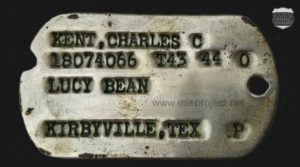 “… Since S/Sgt Bill Sears was captured in Losheimergraben, I took over the squad. We started digging, two men to a hole. I moved into a hole with Basil Moore. We put a telephone in that hole that went back to Lt Shannon who was then Company Commander. We also had a phone going to an outpost a100 yards out in a line of trees… A few nights later, just before daylight, our outpost called and said they could see some men out in front of them. We asked Lt Shannon if there was a patrol of ours supposed to come back through us. He said no and we told the outpost to come in and bring the phone. Right after that the Germans began showing up along the tree line where our outpost had been. We started firing, the artillery tried to help but couldn’t do much, the range was too short. C Co had a mortar and got Moore, who was a mortar Sgt, to work the tree line with it. About this time, a group of Germans, maybe 10 to 15, tripped a flare just to our left and started to wave a white flag. We didn’t fire and asked Lt Shannon about prisoners. By the time we got the answer of no, the flare had burned out, the fire fight stopped and the Germans pulled back. After the fire fight had stopped and good daylight, I went with an other guy to the tree line and counted about 20 to 30 dead or wounded Germans. I gave water to two or three who wanted it. While picking up their weapons, I noticed a bracelet on one of the dead Germans. I have wondered many times where he got it and what it meant to him…
“… Since S/Sgt Bill Sears was captured in Losheimergraben, I took over the squad. We started digging, two men to a hole. I moved into a hole with Basil Moore. We put a telephone in that hole that went back to Lt Shannon who was then Company Commander. We also had a phone going to an outpost a100 yards out in a line of trees… A few nights later, just before daylight, our outpost called and said they could see some men out in front of them. We asked Lt Shannon if there was a patrol of ours supposed to come back through us. He said no and we told the outpost to come in and bring the phone. Right after that the Germans began showing up along the tree line where our outpost had been. We started firing, the artillery tried to help but couldn’t do much, the range was too short. C Co had a mortar and got Moore, who was a mortar Sgt, to work the tree line with it. About this time, a group of Germans, maybe 10 to 15, tripped a flare just to our left and started to wave a white flag. We didn’t fire and asked Lt Shannon about prisoners. By the time we got the answer of no, the flare had burned out, the fire fight stopped and the Germans pulled back. After the fire fight had stopped and good daylight, I went with an other guy to the tree line and counted about 20 to 30 dead or wounded Germans. I gave water to two or three who wanted it. While picking up their weapons, I noticed a bracelet on one of the dead Germans. I have wondered many times where he got it and what it meant to him…

Souvenir of North Africa or good luck charm, this is the bracelet Sgt Kent removed from the dead German. It shows symbols which have been used since ancient times, such as crescent moons with star, scimitar swords and elephants. Each sign carries a symbol (honor, virtue, strengh and wisdom) It was supposed to protect the wearer…
« … I remembered the Germans yelling and hollering when they overran us on the 16th December. It kinda give you a chill. That day on the Elsenborn Ridge, I gave it back to them. Abner Hahn, who was about two holes down said he could hear me and was about to holler « Remember the Alamo ». My actions during the firefight may have influenced Lt Shannon in telling me later that day that he was going to turn me for a battlefield commission. I replied that I didn’t know if I could handle it but that I’ll do my best. He said « I know you will ». I believe he had partly made his decision when he had me form the two squads in Elsenborn rather than having one of the higher ranking Sgt’s do that. Then later by putting the phone connection from his hole to ours. He had me carry out the tasks he wanted done – inventory weapons, ammo, clothing needs, dogtags, string barbed wire, place mines and trip flares. In fact, I did not receive my battlefield commission. Being knocked out of action permanently stopped any further action toward that. I have always had a lot of satisfaction knowing Lt Shannon believed in me and wanted me as his second in command.
That was my last fire fight as I was wounded on Dec 31. I was hit by shell fragments while out of the hole picking up extra weapons. Three shells came in, part of one went through my left arm and knocked me down. I yelled to Basil Moore who was still in the hole that I was going to the rear. When I arrived I told Lt Shannon to tell Moore I was OK. I was but I learned that Moore, although in the hole, was not. In looking over the list of men buried in Henri Chapelle I found Basil Moore, date of death Jan 01, 1945. I never knew if those shells also got Moore… »
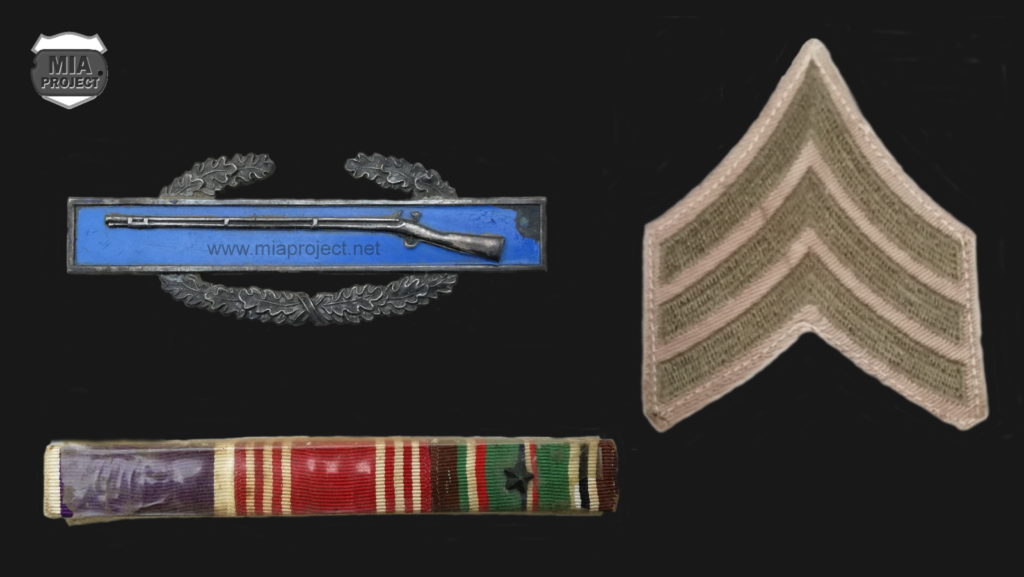
Charles Kent’s CIB, plastified ribbon bar and Sgt stripes, the same ones visible on the 1945 portrait photo.
« … On the Elsenborn Ridge it was very cold and we helped keep our feet from freezing at night by rubbing the feet of the man who was sleeping or trying to sleep. We would alternate staying awake every two or three hours. To keep dry socks we would take off the damp socks and put them between the layers of clothing we had on, then swap back the next day. When I was wounded I had on long underwear, two pair of wool pants, two wool shirts and a new inner lined Mackinaw. I was proud of that Mackinaw as it was much better that the field jacket I had before. A crazy thought I had going down to Lt Shannon’s hole was : « Man, this new coat is ruined ». Little did I know that I would never need it again… »
Charles Kent was discharged at McCloskey General Hospital, Temple, Texas on
February 02, 1946. He reentered Texas A&M University the following week and completed the requirements for a bachelor of Sciences Degree in August 1947. He got married in 1951, raised a family and worked in the paper mill business, ran a flower business and raised pecan orchards. He was a member of the 99th Division association.
Charles C. Kent passed away at his Jasper house on August 19, 2012, at age 93 (see obituary)
Sources:
Letters from Charles C. Kent
Equipment presented on this page was offered by Charles Kent to the MIA Project collections
